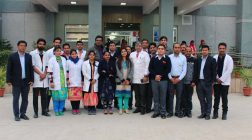The Global Relevance of India’s Pharmaceutical Patent Laws
The recent decision in the Novartis Glivec case continues a long-established tradition of India contesting a Northern agenda on patent laws. This key global role, arising from the exceptional combination of a vibrant domestic pharmaceutical industry with civil society awareness of the public health implications of patents, has been accentuated by recent developments and has continued relevance for the global South.
Denied on the grounds of not having met the standard of efficacy required by Section 3(d) of the 2005 Patent Act, the 1 April 2013 Supreme Court dismissal of the Novartis appeal against the earlier rejection of its patent application for Glivec, an anti-cancer medication, has attracted global attention (e g, Biswas 2013; Chatterjee 2013; The New York Times 2013). In a recent commentary in this journal, Sudip Chaudhuri (2013) has outlined some of the broader implications of the decision, including the linking of the question of patenting with net benefits to society and consideration of the specific conditions of a country.
Here, I argue that the recent pharmaceutical patent law decision continues a long-established tradition of India playing a key global role in contesting a Northern agenda on patent laws. This influence extends well beyond the Indian pharmaceutical industry’s monetary value or immediate geographic location, and arises from the combination of a vibrant domestic industry with civil society awareness of the public health implications of patents.
Leading Patent Law Reform
India has for long been a pioneer in the developing world in attempting to adapt pharmaceutical patent law to take account of domestic health needs and to be in line with its level of development. At the time of Independence in 1947, the colonial Patent Act 1911 was still in place providing for patents on both products and processes (technique of manufacture) in pharmaceuticals. Post-Independence government inquiries, such as the Patents Enquiry Committee 1950 and the Pharmaceutical Enquiry Committee 1954, recommended that patent law should be set to take account of the national interest and the level of development. Government enquiries were also distinguished by a particular reluctance to grant extensive patents on pharmaceuticals.
The Patent Act 1970, based on the recommendations of the 1959 Ayyangar Report, was a crucial initiative to facilitate a domestically-owned pharmaceutical industry as an alternative to the very expensive imported pharmaceuticals. Coming into force in 1972, this Act was designed to offer process patents for only five years, and no product patents, on pharmaceuticals. As has been well documented (e g, Chaudhuri 2005), the change in patent law played a key role in the development of the Indian pharmaceutical industry.
These developments also had a much wider global influence. By reforming its patent law and showing that a substantial pharmaceutical industry could emerge without product patents, India acted as a policy model and became a leading country in placing pharmaceutical patents on the agenda for the New International Economic Order (Patel 1983). Proposing that, where appropriate, each developing country should establish its own pharmaceutical industry, the 1976 Colombo conference of non-aligned countries recommended that, for pharmaceutical patents, states should either shorten the duration of or exclude product patents. The Indian government pushed for a revision of the 1883 Paris Convention on intellectual property (IP), but following demands by developing countries for exclusive compulsory licensing of patents, negotiations on this proposal broke down in 1981.
The approach to IP set by the Indian government, namely that patent law needs to be in line with a country’s level of development, provided an example for other developing countries. Argentina, Brazil, Chile, Mexico and Egypt, all subsequently changed their patent laws. Surendra Patel, a director of United Nations Conference on Trade and Development’s (UNCTAD) technology division and involved in discussions on patents at the United Nations (UN) and UNCTAD from the 1970s to the mid-1980s, later recalled that “whenever I visited the countries of the South in all the three developing continents, I felt proud to receive vicariously compliments from these countries to India on its new patent law” (1992: 103).
Leading Resistance to TRIPS
Subsequently, and largely in response to the India-initiated, public health-oriented patent law reform, the multinational pharmaceutical industry set in train efforts to form a global patent law. Patel (1992) goes as far as to interpret the Uruguay Round of Trade Negotiations, which began in 1986, as resistance to the efforts by the Group of 77 (G77) to establish a New International Economic Order, including reforming the patent law. According to a later statement by the Pharmaceutical Research and Manufacturers of America (PhRMA), the industry association group for multinational pharmaceutical companies, “the Indian patent system was the most direct motivation for US efforts in the Uruguay Round negotiations relating to patents” (PhRMA 1999, cited in Roemer-Mahler 2013: 131).
To overcome the opposition at the World Intellectual Property Organization (WIPO), an agency of the UN, advocates of a global agreement on intellectual property switched the discussions to a forum where developed countries would have more say. In the General Agreement on Tariffs and Trade (GATT), with weighted voting, the rich countries had more power, and developing countries were not organised in the same manner as in the UN system under the G77 (Patel 1992). A few select interests, particularly pharmaceutical companies, from developed countries proved influential in placing IP rights on the global governance agenda at the Uruguay round (e g, Drahos with Braithwaite 2002).
Supported by a broad front of industry and civil society activists, India led the opposition to a global patent law agreement. A National Working Group on Patent Laws (NWGPL) was formed in 1988 at a time when very few places were actively lobbying against the emerging Trade-Related Aspects of Intellectual Property Rights (TRIPS) (ibid: 193). The broader international public health community then showed little interest in IP issues. Groups outside India rarely engaged with the patents and health issue, arguing that the “patent is not important” and instead focused on the irrational prescription of medicines and other issues (Interview, Delhi, 22 May 2012).1 In the meetings of one international public health civil society group, the Indian representatives were on occasion taken to task with such remarks as “I don’t know why you Indians are so bothered about patents” (Interview, Delhi, 12 December 2011).
With its emphasis on the implications of patents for health and development, India stood out as “the principal voice of the developing countries” against American business interests (Steidlmeier 1993: 159). Despite its resistance, however, with declining support elsewhere and growing balance-of-payments problems prompting a tilt towards the US in some aspects of foreign policy, India eventually yielded and agreed to a global patent protocol in 1989 (Patnaik 1992). Developing countries would then have to introduce product and process patents for medicines by 2005.
The Indian Alternative
Particularly as a result of a 2001 legal case between international pharmaceutical companies and the South African government, the issue of access to medicines has assumed global dimensions since the millennium, being part of the November 2001 Doha Declaration on the TRIPS Agreement and Public Health. With its established and increasingly export-oriented pharmaceutical industry being complemented by civil society awareness, India has been at the centre of the global access to medicines campaign. Crucially, the Indian industry gave the campaign an “economic backbone” (Roemer-Mahler 2013: 132) by showing that an alternative to the large, multinational pharmaceutical industry was possible.
In 2001, Cipla offered to supply first generation antiretrovirals (ARVs), then costing $10,000 a year, for $350 a year. This price reduction “hammered the message home that many of the multinational drug companies were abusing their market monopoly in the face of a catastrophic human disaster. It also drew attention to the effects of generic competition in bringing drug prices down” (Hoen et al 2011: 4). For AIDS patients, this development transformed the disease from a killer to an issue of chronic management. By the mid-2000s, the Indian pharmaceutical industry had achieved a particular repute because of “the natural production capacity, the expertise to produce in greater quantities and competition to bring down prices” (Interview, Mumbai, 24 October 2011).
As the final adjustment to make India’s patent law TRIPS compliant was being introduced, an editorial in The New York Times (2005) argued that “seldom has India’s Parliament considered anything of such global import”. The public health safeguards in the 2005 Patent Act, including provisions for compulsory licensing and restricting incremental innovation (through Section 3(d) – subsequently crucial in the Novartis case), were inspired by both domestic organisations and transnational groups such as Médecins Sans Frontières (MSF). Also active in the domestic access to medicines campaign, working with such groups as the Delhi Network of Positive People and the Lawyers Collective, MSF helped build an image of India as the “pharmacy of the developing world”.
Cheap production from India has enabled HIV medicines to reach millions of people in developing countries (Hoen et al 2011). Brazil, for example, with the largest free and universal access programme for anti-AIDS drugs in the developing world, is strongly supported by Indian supply (Guennif 2011). More than 80% of the donor-funded purchases in the ARV market now come from Indian generic manufacturers (Waning et al 2010). By providing competition in antibiotics and other unspecified medicaments (Hafner and Popp 2011), supply from India (and China) has lowered medicine prices in many parts of the global South.
Continued Contestation?
As India has developed and transnational pressures have continued, the policy landscape surrounding pharmaceutical patenting has become more complex and divided. Pressure by the US, European Union (EU) and Japan has built to implement TRIPS-plus measures involving patent term extensions, data-exclusivity, and increased border and enforcement. Increased scope and duration of patentability feature in such bilateral and regional trade negotiations as the EU-India free trade agreement, the EU-Canada trade discussions and the US-led Trans-Pacific Partnership.
At the same time, domestic pressures are also changing. Many pharmaceutical firms, now engaged in partnerships with foreign multinationals and focusing more on the substantial revenues that can be earned from high-income regulated markets (Horner 2013), no longer openly contest strong patent protection. Indeed, some now support a stronger patent law, stating that “IP is highly valued” (Interview, Hyderabad, 15 November 2011). The broad-based, outright opposition within India to the Northern agenda of increasing the scope of IP has declined.
Recent patent law decisions, including that of the Supreme Court in the Novartis case, indicate that India continues to put a premium on public health in relation to pharmaceutical patent law decisions. In March 2012, India’s first compulsory licence under TRIPS was issued, on the grounds of lack of affordability, to Natco Pharma to produce Bayer’s liver and cancer drug Nexavar (sorafenib). Natco is now able to sell the drug at Rs 8,800 for a month’s treatment, compared to Bayer’s Rs 2,80,000 (Bhaumik and Biswas 2012). The prices of some other cancer drugs have also since been reduced. That decision attracted the wrath of IP interests in the US, with the Office of the US Trade Representative placing India on its 2012 “priority-watch list” for countries suspected of potentially violating IP law.
Pharmaceutical patent decisions in India continue to have significance internationally as policy examples, especially in low-income and middle-income countries. Recent collaboration between the Treatment Action Campaign and MSF to organise a “Fix the Patent Laws” campaign in South Africa has aimed to draw lessons from India. Since the recent compulsory licence decision, China has implemented similar laws, while the Argentine and Philippine governments have announced they will do the same (ibid). The Novartis decision may have a similar effect, becoming another indication of India’s role in leading public health-oriented patent law reform within the global South.
Rather than a transition to patent laws similar to those of the global North, recent decisions suggest a more progressive balance may be found in India between increasing patent protection, ensuring access to technology, and prioritising public health. Many countries have changed their patent laws during economic development, with a general interpretation being that rising powers are likely to strengthen IP rights as they “climb the development ladder” (Archibugi and Filippetti 2010: 145).
In the case of China, Yu (2012: 573) has observed the emergence of “schizophrenic” IP policies whereby the state is “on the side of the developing world with respect to some issues, but on the side of the developed world with respect to others”. This is part of China “crossing over” from “a pirating nation to a country respectful of intellectual property rights” (ibid: 528).
With access to medicines still a major issue in India (Phadke 2011; Srinivasan 2011), the Novartis decision continues India’s leading role at the forefront of developing a more public health-oriented pharmaceutical patent law of general global relevance.
Note
1 All the interviews cited in this article were conducted as research for my PhD dissertation (2013) – “The State, Patents and the Development of India’s Pharmaceutical Industry”, Graduate School of Geography, Clark University, USA. I sincerely thank all interviewees who participated in the research project.
References
Archibugi, Daniele and Andrea Filippetti (2010): “The Globalisation of Intellectual Property Rights: Four Learned Lessons and Four Theses”, Global Policy, 1(2): 137-49.
Biswas, Soutik (2013): “Is Novartis Ruling a Watershed?”, BBC News, 1 April, viewed on 2 April 2013,http://www.bbc.co.uk/news/world-asia-india-21992237
Bhaumik, Soumyadeep and Tamoghna Biswas (2012): “From Outlier to Trendsetter”, Canadian Medical Association Journal, 184(12): E635-36.
Chatterjee, Patralekha (2013): “India’s Patent Case Victory Rattles Big Pharma”, The Lancet, 381(9874): 1263.
Chaudhuri, Sudip (2005): The WTO and India’s Pharmaceutical Industry: Patent Protection, TRIPS and Developing Countries (New Delhi: Oxford University Press).
– (2013): “The Larger Implications of the Novartis-Glivec Judgment”, Economic & Political Weekly, 48(17): 10-12.
Drahos, Peter with John Braithwaite (2002): Information Feudalism: Who Owns the Knowledge Economy? (London: Earthscan Publications).
Guennif, Samira (2011): “The Importance of Generic Drugs in the South: Behind the Brazilian Anti-AIDS program, the Indian Performance in the Pharmaceutical Sector”, Centre d’Economie de l’Université Paris Nord, Université Paris13.
Hafner, Tamara and David Popp (2011): “China and India as Suppliers of Affordable Medicines to Developing Countries”, NBER Working Paper No 17249, National Bureau of Economic Research, Cambridge Massachusetts.
Hoen, Ellen ‘t, Jonathan Berger, Alexandra Calmy and Suerie Moon (2011): “Driving a Decade of Change: HIV/AIDS, Patents and Access to Medicines for All”, Journal of the International AIDS Society, 14: 15.
Horner, Rory (2013): “The Impact of Patents on Innovation, Technology Transfer and Health: A Pre- and Post-TRIPs Analysis of India’s Pharmaceutical Industry”, New Political Economy, 29 May, doi: 10.1080/13563467.2013.796446
Patel, Surendra J (1983): “Third World Initiatives on Pharmaceuticals: A Documentation for the Record”, The IDS Bulletin, 14(4): 71-78.
– (1992): “Statement to the Group of Ministers on Arthur Dunkel’s Draft of the Final Act on Uruguay Round of GATT Negotiations”, Social Scientist, 20(1/2): 99-107.
Patnaik, Jagadish K (1992): “India and the TRIPs: Some Notes on the Uruguay Round of Negotiations”, India Quarterly, 48(4): 31-42.
Phadke, Anant (2011): “Planning Healthcare for All?”, Economic & Political Weekly, 46(21): 15-18.
Roemer-Mahler, Anne (2013): “Business Conflict and Global Politics: The Pharmaceutical Industry and the Global Protection of Intellectual Property Rights”, Review of International Political Economy, 20(1): 121-52.
Srinivasan, S (2011): “‘Medicines for All’, the Pharma Industry and the Indian State”, Economic & Political Weekly, 46(24): 43-50.
Steidlmeier, Paul (1993): “The Moral Legitimacy of Intellectual Property Claims: American Business and Developing Country Perspectives”, Journal of Business Ethics, 12(2): 157-64.
The New York Times (2005): “AIDS Drugs Threatened”, 5 March, viewed on 31 October 2012,http://www.nytimes.com/2005/03/05/opinion/05sat3.html
– (2013): “India’s Novartis Decision”, 4 April, viewed on 10 April 2013, http://www.nytimes.com/2013/ 04/05/opinion/the-supreme-court-in-india-clarifies-law-in-novartis-decision.html
Waning, Brenda, Ellen Diedrichsen and Suerie Moon (2010): “A Lifeline to Treatment: The Role of Indian Generic Manufacturers in Supplying Antiretroviral Medicines to Developing Countries”, Journal of the International AIDS Society, 13: 35, viewed on 25 October 2012, http://archive.biomedcentral.com/1758-2652/13/35/
Yu, P (2012): “The Rise and Decline of the Intellectual Property Powers”, Campbell Law Review, 34(3): 525-77.










